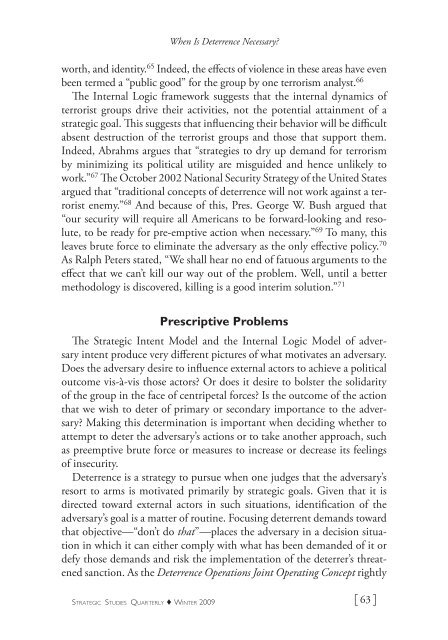When Is Deterrence Necessary? Gauging Adversary Intent
When Is Deterrence Necessary? Gauging Adversary Intent
When Is Deterrence Necessary? Gauging Adversary Intent
Create successful ePaper yourself
Turn your PDF publications into a flip-book with our unique Google optimized e-Paper software.
<strong>When</strong> <strong>Is</strong> <strong>Deterrence</strong> <strong>Necessary</strong>?<br />
worth, and identity. 65 Indeed, the effects of violence in these areas have even<br />
been termed a “public good” for the group by one terrorism analyst. 66<br />
The Internal Logic framework suggests that the internal dynamics of<br />
terrorist groups drive their activities, not the potential attainment of a<br />
strategic goal. This suggests that influencing their behavior will be diffcult<br />
absent destruction of the terrorist groups and those that support them.<br />
Indeed, Abrahms argues that “strategies to dry up demand for terrorism<br />
by minimizing its political utility are misguided and hence unlikely to<br />
work.” 67 The October 2002 National Security Strategy of the United States<br />
argued that “traditional concepts of deterrence will not work against a terrorist<br />
enemy.” 68 And because of this, Pres. George W. Bush argued that<br />
“our security will require all Americans to be forward-looking and resolute,<br />
to be ready for pre-emptive action when necessary.” 69 To many, this<br />
leaves brute force to eliminate the adversary as the only effective policy. 70<br />
As Ralph Peters stated, “We shall hear no end of fatuous arguments to the<br />
effect that we can’t kill our way out of the problem. Well, until a better<br />
methodology is discovered, killing is a good interim solution.” 71<br />
Prescriptive Problems<br />
The Strategic <strong>Intent</strong> Model and the Internal Logic Model of adversary<br />
intent produce very different pictures of what motivates an adversary.<br />
Does the adversary desire to influence external actors to achieve a political<br />
outcome vis-à-vis those actors? Or does it desire to bolster the solidarity<br />
of the group in the face of centripetal forces? <strong>Is</strong> the outcome of the action<br />
that we wish to deter of primary or secondary importance to the adversary?<br />
Making this determination is important when deciding whether to<br />
attempt to deter the adversary’s actions or to take another approach, such<br />
as preemptive brute force or measures to increase or decrease its feelings<br />
of insecurity.<br />
<strong>Deterrence</strong> is a strategy to pursue when one judges that the adversary’s<br />
resort to arms is motivated primarily by strategic goals. Given that it is<br />
directed toward external actors in such situations, identification of the<br />
adversary’s goal is a matter of routine. Focusing deterrent demands toward<br />
that objective—“don’t do that”—places the adversary in a decision situation<br />
in which it can either comply with what has been demanded of it or<br />
defy those demands and risk the implementation of the deterrer’s threatened<br />
sanction. As the <strong>Deterrence</strong> Operations Joint Operating Concept rightly<br />
Strategic Studies Quarterly ♦ Winter 2009 [ 63 ]
















